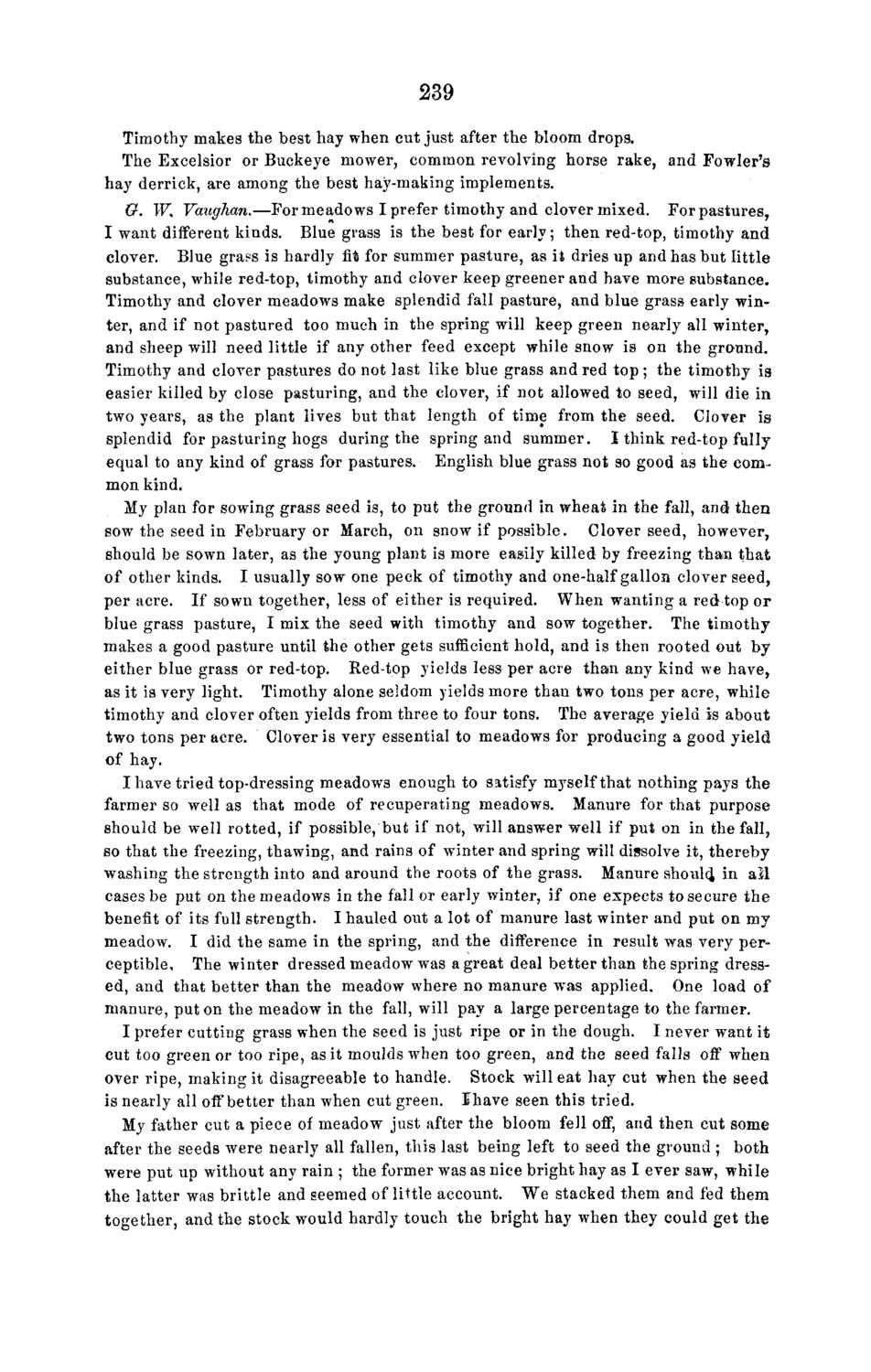| |
| |
Caption: Board of Trustees Minutes - 1868
This is a reduced-resolution page image for fast online browsing.

EXTRACTED TEXT FROM PAGE:
239 Timothy makes the best hay when cut just after the bloom drops. The Excelsior or Buckeye mower, common revolving horse rake, and Fowler's hay derrick, are among the best hay-making implements. G. W% Vaughan.—For meadows I prefer timothy and clover mixed. For pastures, I want different kinds. Blue grass is the best for early; then red-top, timothy and clover. Blue grass is hardly fit for summer pasture, as it dries up and has but little substance, while red-top, timothy and clover keep greener and have more substance. Timothy and clover meadows make splendid fall pasture, and blue grass early winter, and if not pastured too much in the spring will keep green nearly all winter, and sheep will need little if any other feed except while snow is on the ground. Timothy and clover pastures do not last like blue grass and red top; the timothy is easier killed by close pasturing, and the clover, if not allowed to seed, will die in two years, as the plant lives but that length of time from the seed. Clover is splendid for pasturing hogs during the spring and summer. I think red-top fully equal to any kind of grass for pastures. English blue grass not so good as the common kind. My plan for sowing grass seed is, to put the ground in wheat in the fall, and then sow the seed in February or March, on snow if possible. Clover seed, however, should be sown later, as the young plant is more easily killed by freezing than that of other kinds. I usually sow one peck of timothy and one-half gallon clover seed, per acre. If sown together, less of either is required. When wanting a red top or blue grass pasture, I mix the seed with timothy and sow together. The timothy makes a good pasture until the other gets sufficient hold, and is then rooted out by either blue grass or red-top. Red-top yields less per acre than any kind we have, as it is very light. Timothy alone seldom yields more than two tons per acre, while timothy and clover often yields from three to four tons. The average yield is about two tons per acre. Clover is very essential to meadows for producing a good yield of hay. I have tried top-dressing meadows enough to satisfy myself that nothing pays the farmer so well as that mode of recuperating meadows. Manure for that purpose should be well rotted, if possible, but if not, will answer well if put on in the fall, so that the freezing, thawing, and rains of winter and spring will dissolve it, thereby washing the strength into and around the roots of the grass. Manure shoul<J in all cases be put on the meadows in the fall or early winter, if one expects to secure the benefit of its full strength. I hauled out a lot of manure last winter and put on my meadow. I did the same in the spring, and the difference in result was very perceptible. The winter dressed meadow was a great deal better than the spring dressed, and that better than the meadow where no manure was applied. One load of manure, put on the meadow in the fall, will pay a large percentage to the farmer. I prefer cutting grass when the seed is just ripe or in the dough. I never want it cut too green or too ripe, as it moulds when too green, and the seed falls off when over ripe, making it disagreeable to handle. Stock will eat hay cut when the seed is nearly all off better than when cut green. Ihave seen this tried. My father cut a piece of meadow just after the bloom fell off, and then cut some after the seeds were nearly all fallen, this last being left to seed the ground ; both were put up without any rain ; the former was as nice bright hay as I ever saw, while the latter was brittle and seemed of little account. We stacked them and fed them together, and the stock would hardly touch the bright hay when they could get the
| |